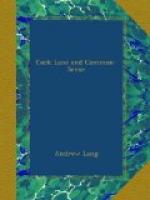Much has been done, since 1856, towards producing a finished picture, in place of an ebauche. The accepted belief in the phenomena of hypnotism, and of unconscious mental and bodily actions—’automatisms’—has expelled the old belief in spirits from many a dusty nook. But we still ask: ’Do objects move untouched? why do they move, or if they move not at all (as is most probable) why is it always the same story, from the Arctic circle to the tales of witches, and of mediums?’
There is little said about this particular phenomena (though something is said), but there is much about other marvels, equally widely rumoured of, in the brief and dim Greek records of thaumaturgy. To examine these historically is to put a touch or two on the picture of ‘demoniac affections,’ which M. Littre desired to see executed. The Greek mystics, at least, believed that the airy music, the movements of untouched objects, the triumph over gravitation, and other natural laws, for which they vouch, were caused by ‘demons,’ were ‘demoniac affections’. To compare the statements of Eusebius and Iamblichus with those of modern men of science and other modern witnesses, can, therefore, only be called superfluous and superstitious by those who think M. Littre superstitious, and his desired investigation ‘superfluous’.
When the epidemic of ‘spiritualism’ broke out in the United States (1848-1852) students of classical literature perceived that spiritualism was no new thing, but a recrudescence of practices familiar to the ancient world. Even readers who had confined their attention to the central masterpieces of Greek literature recognised some of the revived ‘phenomena’. The ‘Trance Medium,’ the ‘Inspirational Speaker’ was a reproduction of the maiden with a spirit of divination, of the Delphic Pythia. In the old belief, the god dominated her, and spoke from her lips, just as the ‘control,’ or directing spirit, dominates the medium. But there were still more striking resemblances between ancient and modern thaumaturgy, which were only to be recognised by readers of the late Neoplatonists, such as Porphyry, and of the Christian Fathers, such as Eusebius, who argued against the apologists of heathenism. The central classical writers, from Homer to Tacitus, are not superstitious; they accept the orthodox state magic of omens, of augurs, of prodigies, of oracles, but anything like private necromancy is alien and distasteful to them. We need not doubt that sorcery and the consultation of the dead were being practised all through the classical period, indeed we know that it was so. Plato legislates against sorcery in a practical manner; whether it does harm or not, men are persuaded that it does harm; it is vain to argue with them, therefore the wizard and witch are to be punished for their bad intentions. {62}




